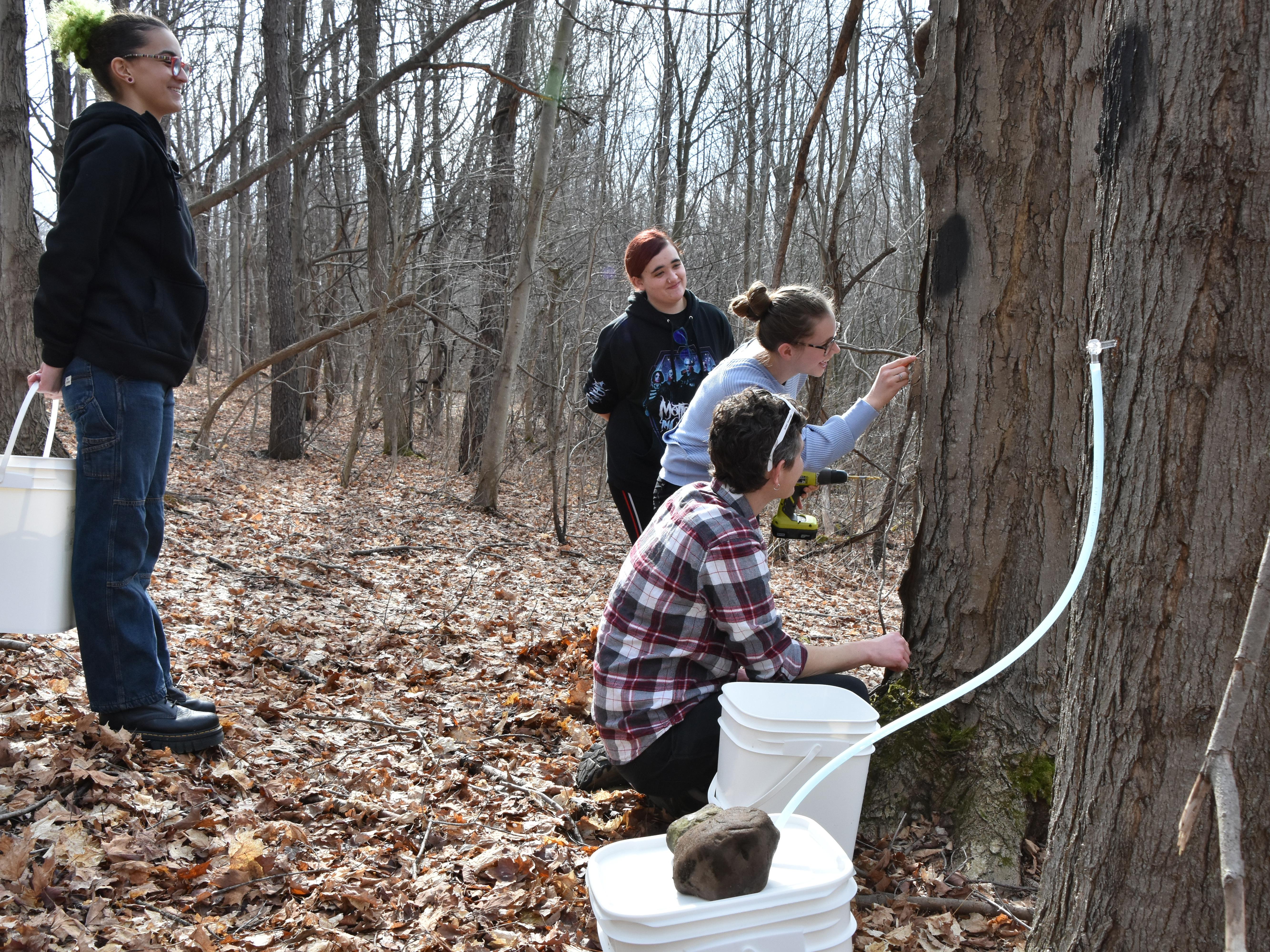Students draw sap from maple trees during the annual Maple on Tap program that is a collaboration of the university's Office of Sustainability and several academic departments. It is one of many activities that earned SUNY Oswego continuing Tree Campus Higher Education recognition from the Arbor Day Foundation.
SUNY Oswego welcomed its second year of Tree Campus Higher Education recognition from the Arbor Day Foundation by continuing efforts that include tree planting and restoration, working with classes on initiatives and hosting community events.
The Arbor Day Foundation is the world’s largest membership nonprofit organization dedicated to planting trees. Its Tree Campus Higher Education program began in 2008 to encourage colleges and universities to plant trees on their campuses.
“The recognition honors a lot of work that we do for all the right reasons as an educational institution,” said Kate Spector, director of the Office of Sustainability. “Given our unique natural setting on the shores of Lake Ontario, it’s easy to see why having a healthy and plentiful variety of trees is important – to those of us on campus now and those to come for generations.”
The campus continued its Maple on Tap project, working with classes and volunteers to tap maple trees at the university’s Fallbrook location. The sap from those efforts gets boiled down into maple syrup, which will be served as part of a community celebration on Arbor Day weekend.
The effort welcomed students from one of Michael Chaness’ Native American studies class, an education course taught by Benjamin Scherrer, Florencia Lauria's class on indigenous literature, student filmmakers from courses taught by Tiffany Deater and Jarrod Hagadornin in cinema and screen studies, and Eric Hellquist’s biological sciences courses.
Faculty and student involvement has also supported planting more native pollinators near the Marano Campus Center and Dr. Mary Walker Health Center. Spector said Hellquist and his students have been very supportive with expertise, enthusiasm and time.
“We’re blessed to have so many people, like Dr. Hellquist and his classes, on campus who bring knowledge and passion on efforts supporting the environment and sustainability,” Spector said.
In addition, Spector offered thanks to students who participated in the alternative spring break staycation program for their support.
Two-day celebration
On the traditional Arbor Day, April 25, the campus will host the planting of new trees in the Centennial Arboretum on the corner of Washington Boulevard and Sixth Avenue, next to the Mackin Complex.
A tree planting in 1961 honored the 100th anniversary of the founding of the institution now known as SUNY Oswego. But as the campus grew west –- leaving the arboretum on one edge of campus, and its original tenders turned over –- the site grew somewhat neglected. That changed with a revitalization in 2021, thanks to the efforts of the university’s Office of Sustainability and Rice Creek Field Station and the local Oswego Tree Stewards.
Since then, the Office of Sustainability has worked with student groups for planting and maintaining the trees, planting more every year.
“In a way, that renewal of the arboretum is symbolic of the efforts that went into making us a Tree Campus, thinking of what we can do now and into the future to allow our campus’ unique natural setting to survive and thrive,” Spector said.
On April 26, the campus and community are invited to a special pancake breakfast at Rice Creek Field Station, which will feature the maple syrup from the Maple on Tap project. Admission is a $10 suggested donation, but all are welcome. Donations will benefit the Students Helping Oz Peers (SHOP) pantry and an Auxiliary Services fund that supports food-insecure students.
“It’s a popular and fabulous gathering that connects a lot of what we do,” Spector said.
Also on April 26, Rice Creek Field Station will host its admission-free and family-friendly National Arbor Day Festival, with tree giveaways, nature-related activities for all ages, presentations, student research and more from 10 a.m. to 4 p.m.
Importance of trees
Cory Brosch from Counseling Services, who also co-chairs the Campus Environmental Action Committee, noted that time in nature –- supported by a healthy tree population –- is good for anybody’s health.
“Spending time in nature can reduce anxiety, depressive symptoms and loneliness; improve concentration and connections; and can help you develop a sense of meaning,” Brosch said. “Being in nature helps us be mindful and makes our senses engaged in healthy ways. Spending time in nature helps you take a break when you’re stressed or overwhelmed and can help you connect with other living things.”
SUNY Oswego is known for the lake, the natural setting and the sense of place, and trees are a big part of that, she said.
“You feel like you connect with a place, belong in a place and know who you are, and that’s true of our campus,” Brosch said. “So many students talk about the lake, and it’s very powerful to the sense of place. The ecosystem of the lake is very important and trees are a part of that.”
The Tree Campus designation supports this sense of place by ensuring the institution is intentional about maintaining trees, replacing them when necessary and planting new trees that are native species that can thrive, Brosch said.
“We know it’s spring because all the leaves come out and we see so many things turning green,” Brosch noted. “People talk about the fall colors and that’s because of deciduous trees turning different colors. You see constant change, that’s a really good metaphor for life.”
Brosch noted that humans and trees are a perfect example of a reciprocal relationship, as trees give off oxygen and absorb carbon dioxide, while humans do the opposite. It’s a vital balance that encourages a healthy co-existence.
“If the Tree Campus designation helps ensure SUNY Oswego finds nature as something we value, that’s important,” Brosch said. “That will make for happier and healthier students, faculty and staff, and a happier and healthier campus ecosystem.”




